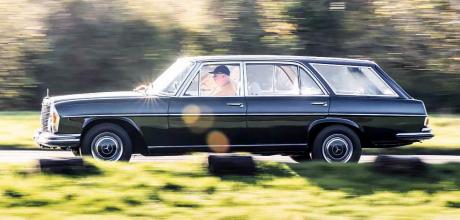1969 Mercedes-Benz 300SEL 6.3 Estate by Crayford W109
Once the company car of the world’s oldest surviving F1 driver, and the only one of its kind: James Elliott drives the Crayford Mercedes-Benz 300SEL 6.3 Estate.
Photography Barry Hayden
MERCEDES SEL 6.3 ESTATE — Ultimate hot rod saloon, converted by Crayford
All car nerds are drawn to a supersaloon — and the crazier the better, whether it be Lotus Carlton or earsplitting Aussie V8s tearing up Mount Panorama — but we tend to go even more weak-kneed at the sight of an insane estate. There is an irresistible sense of two-fingered defiance in even the mere gesture of creating a bonkers family wagon: you should fear the out-and-out beefcake less than the big out-of-shape kid with the wild glint in his eye.
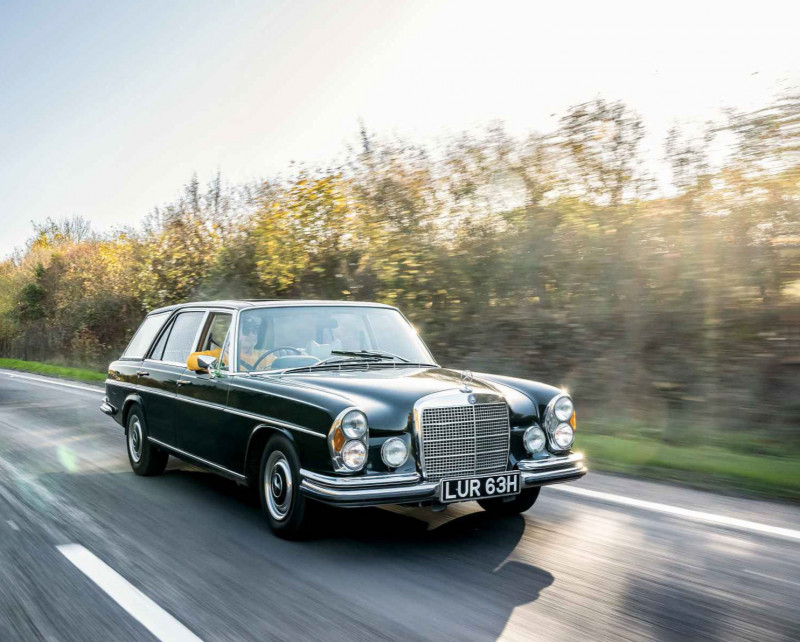
So, not your sporting shooting brake like a Radford DBS or whatever, but a proper four-door, two-box tip-trip-meister. This rebellion was never better epitomised than by Rydell and Lammers racing Volvo-TWR 850 estates in the 1994 British Touring Car Championship, while Audi and Porsche established a template for all wild wagons since in the RS2… yet both were already 25 years behind the game.
‘THE ONLY WAY TO DESCRIBE DRIVING THE MERCEDES-BENZ 300 SEL 6.3 IS “WAFTING WITH MENACES’”
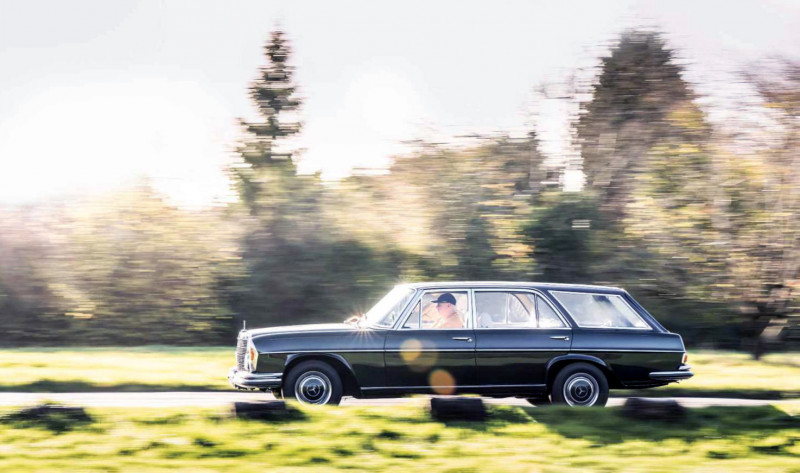
If you wanted a bona fide super-estate back in the late 1960s, you could either up-engine an existing wagon (Cortina Savage Estate, for example) or estatify an existing supersaloon. And if you went for the latter option there was one stand-out candidate, the only true four-door supersaloon of the era until Jaguar put 12s in its 6s, the Mercedes-Benz 300 SEL 6.3.
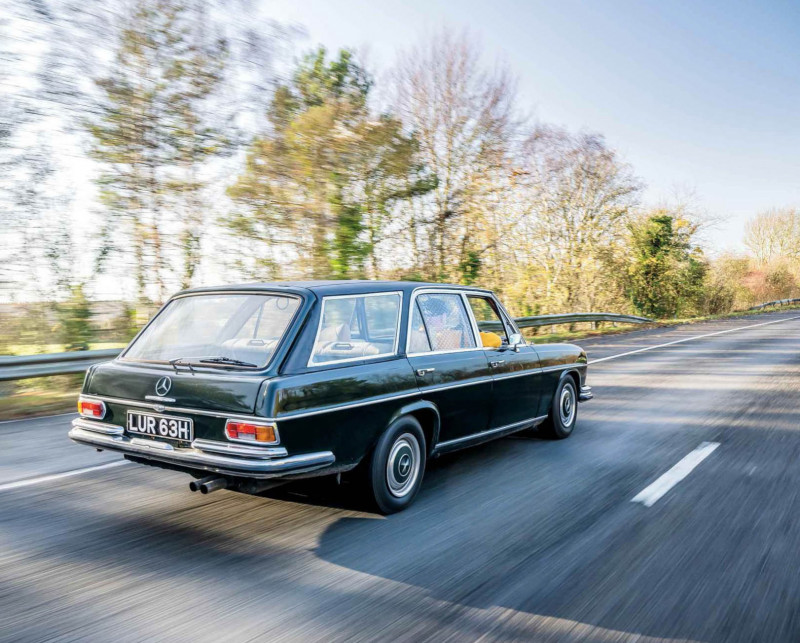
Coming towards the end of Merc’s most stately stacked- headlight pomp (courtesy of Paul Bracq), the 300 SEL inline-six version of the sophisticated air-suspended mid- ’60s W108/109 full-size saloon (for convenience’s sake, we’ll call it an S-Class) should have satisfied most appetites, but, if not, surely the proposed 3.5 V8 that would emerge in August 1969 would be all the continent-shrinking executive saloon that anyone could ever have wanted.
‘Anyone’ clearly did not include Erich Waxenberger, former understudy to Rudolf Uhlenhaut and at that point head of Mercedes’s experimental division. Since 1966, Waxenberger had been busy cramming the 6.3-litre M100 from the Merc 600 into the S-Class platform. The result was a Q;car to trounce all others. More than 6500 were built from 1968 to 1972, before it was supplanted by the 450 SEL 6.9 — the W116 generation, and first officially to be labelled by Mercedes-Benz as Sonderklasse (special class’, or S-Class). Weighing just shy of two tonnes, it overcame its weight disadvantage with brute force, offering 0-60mph in 6.5sec and a top speed of around 140mph, courtesy of 250bhp and 370lb ft of torque.
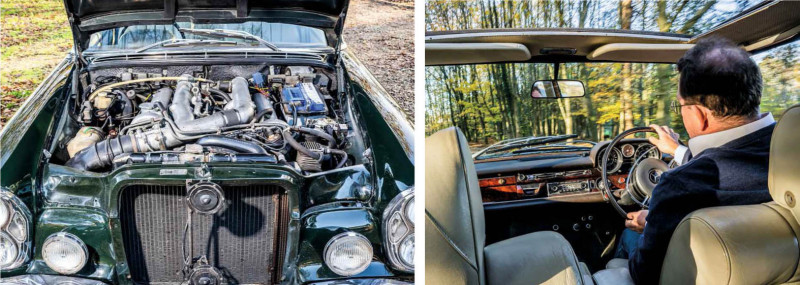
Yet meld all that power with top-notch appointments, the ride comfort provided by air suspension, a smooth auto box, power steering, powered disc brakes, electric windows and an option list bursting with luxury, and here was an unprecedented manner in which to convey five people at very rapid speeds. If not necessarily the first, the 6.3 was surely the definitive supersaloon, and even now it is hard to think of a car more suited to the description. So, what could be better? An estate, of course. Enter Crayford.
If you think Crayford was all about convertible Cortinas, think again. Probably best-known for the Heinz 57 Wolseley Hornet drop-tops, the Kent company was founded in 1962 by engineer Jeffrey Smith and sales maestro David McMullan. It started by offering Mini convertibles before moving on to other marques, including Mercedes, with which it had a long association — despite Mercedes’ initial legal action to stop the conversions and even to pulp the sales material because of its use of the three-pointed star.
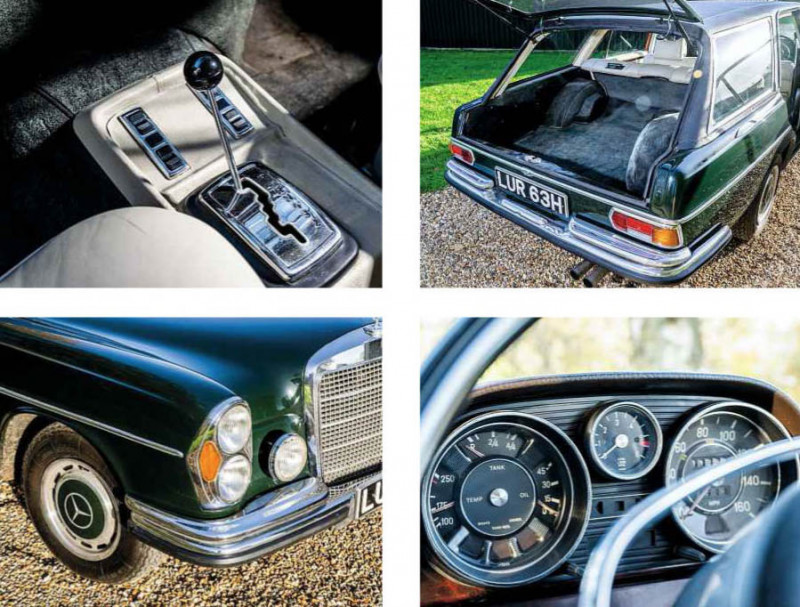
The most popular collaboration’ would be the 280 CE St Tropez convertible, but other gems included a one-off W116 S-Class four-door convertible and long-wheelbase W114-based Dachshund. But before all those came the S-Class estate. The company is believed to have created a dozen, including one based on a 6.3. And if the Mercedes-Benz 300SEL 6.3 was strictly for the obscenely wealthy, then a Crayford version would be the preserve of genuine tycoons. Enter Kenneth McAlpine.
Now 102 years old, he is of course from the family behind the UK building and engineering conglomerate, but was also a racing driver of some note, having competed in seven F1 races for Connaught (starting with Silverstone in 1952) and at Le Mans. Such was his commitment to Connaught that he poured a portion of his family fortune into it and was formally an entrant until he pulled back from racing to focus on the family business in 1958.
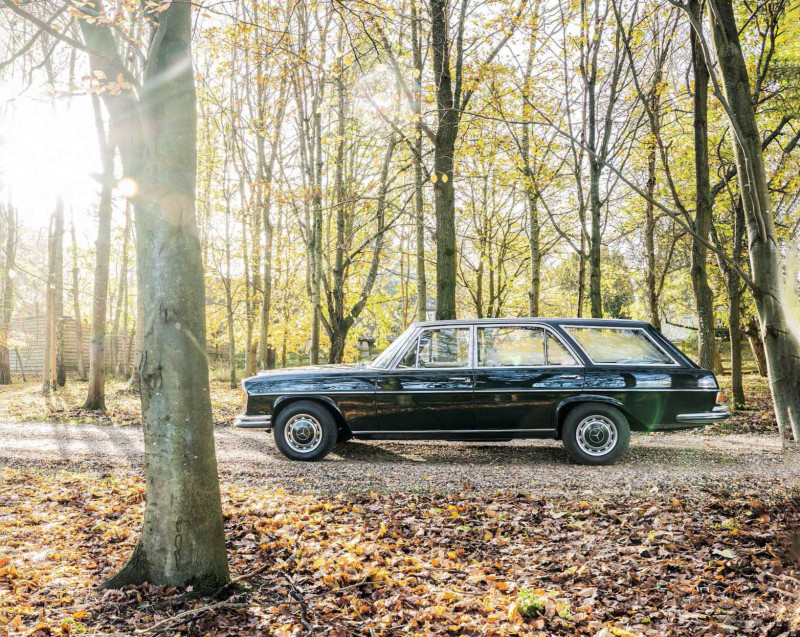
That date sadly means you can instantly dispel romantic visions of McAlpine rapidly using this one-off car to dash down to Monaco at breakneack speed with a spare Alta engine for Bernie Ecclestone’s Connaught Type B; in period the 6.3’s cavernous boot probably carried nothing more racy than a hard hat, donkey jacket and a pair of wellies as he toured the country visiting the company sites. Which it did a lot, 65,000 miles’ worth over 20 years, in fact.
McAlpine bought the 6.3 new (reputedly the first of 702 right-hookers to reach the UK), having paid £5918 for it on 20 June 1969. He ran it for a year before sending it to Crayford and spending a further £3550 on it (that in itself would have bought a nice house in Fulham). Works included not only the body conversion but also a rear seat modified to carry three people and to fold down to increase load space, plus a rear boot floor tool compartment cover.
For 20 painstakingly documented years it was believed to be McAlpine’s daily driver, meticulously maintained by Mercedes of Mayfair. Then, unusually for a private seller, he took out a full-page advert in Car to sell ‘The World’s Fastest Estate Car’ for £7500. Over the next 30 years it fell off the radar as the second owner used it sparingly before putting it on the market in 2021. Initially it was entered for H&H Classics’ Duxford auction and its re-emergence caused a stir, not all of it positive, especially on Mercedes-Benz forums. Some questioned the looks of the conversion, others criticised the lack of use (stored since its last MoT in 2015, just 4000 miles since 1989), but most were perplexed by the H-prefix plate: a car cannot wear a plate younger than itself, which set alarm bells ringing. Of course, with just two owners, it might have been wiser to assume that the DVLA
had mistakenly issued a new registration when it was previously sold and the McAlpine private plate taken off it. Or had simply confused prefix and suffix. That it was then withdrawn from the sale further dented buyer confidence.
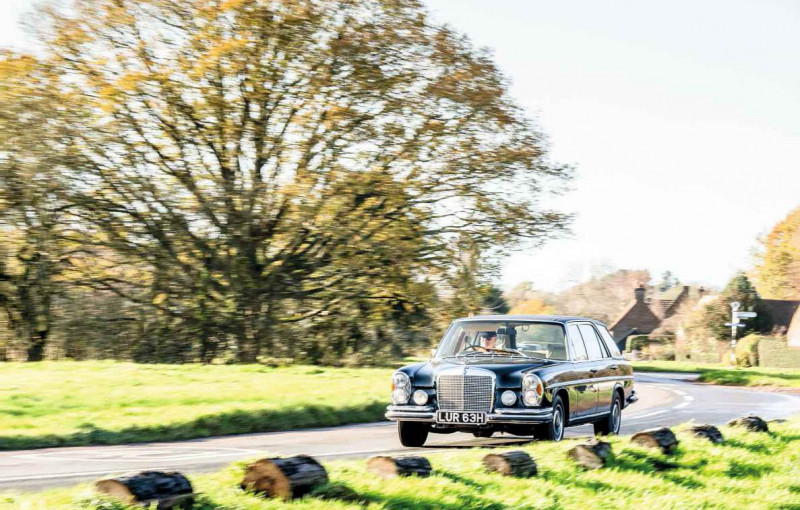
All this undoutedly helped stifle the bidding when it popped up again on Collecting Cars in January 2022, and the guy who snapped it up for £35,000 was over the moon. ‘I did my homework and knew it was good,’ he says. ‘It hadn’t been used much, but it had been maintained and then serviced in 2021, plus the listing said it had been checked over by Paul Sumner of [Mercedes specialist] Roger Edwards, so I just phoned him and asked. He told me: “The air suspension has all been done and it’s not rotten — there’s some bubbly paint we’ll need to do but it’s rock solid — and that’s all you need to know with one of these.” He reckoned it would cost me about £10-15k on top of purchase. A 6.3. Estate. Crayford.
McAlpine owned. It just pressed so many buttons, and when it comes to cars my buttons are easily pressed. I had to have it whatever bloody price it was.’
As always, there was history behind the mania. Among myriad interesting cars owned by this self-confessed addict had previously been three 6.3s, 6.9s, a 600, Gullwing, an SL129, a cabrio 220, a couple of ESOOs and an E60. I have always admired that peak Mercedes engineering period, the whole wolf in sheep’s clothing thing, but especially the 6.3 because of the way it was created, almost a skunkworks job.’
The car was taken straight from the auction to Roger Edwards. There it received a whole new braking system, top-end engine rebuild, new tyres (the ones on it were 30 years old), a rebuilt diff and a steering refurb. As predicted by Paul Sumner, the financial bargepole job on these cars — the air suspension — was not necessary. The bubbly paint turned out to be more of an issue, however, not because it hid greater lurking horrors, but because so many small areas had been treated that a full respray in the gorgeous dark olive non-metallic (code 291) was necessary — and the new owner had wanted to keep as much as possible exactly how Kenneth McAlpine had it.
‘Sadly the sheer quantity was enough just to tip it from touch-ups to full respray. I thought, sod it, I’ve got no choice and cars always drive nicer when they’ve got fresh paint anyway.’ As for the interior, the wood was stripped out and redone, but otherwise the ivory leather is largely original.
The owner is happy. ‘It is exactly how I wanted it. I didn’t want a brand new car, the aim was to keep it as original as possible and cruise at a bloody lovely speed in silence, like a post-war nuclear submarine. It’s just a lovely piece of British- German history and I’m the perfect owner for it really, because it certainly won’t sit in an air-conditioned glass cube with me — I will drive and use it, but I will also really look after it and celebrate it.’
It is easy to see why. Trawl the internet and you might happen across another, mid-’70s US 6.3 conversion that flattened off the rear end while the Grayford effort used the existing boot-line and stepped it up to a Ford Granada Mkl tailgate for a fantastic organic finish. Even the exposed hinges on the roof don’t look out of place, though it is hard to imagine that the factory would have left them visible. It all gets a little complicated around the top of the D-pillar, but the tailgate blends in very nicely. Can the same be said about the windows? They are perhaps fractionally too rhomboid and a few more curves might have made them sit easier on the side of the 300 SEE, but they offer a fine view of the rear deck, which is gargantuan even with the beautifully engineered folding rear seat in the upright position.
All the options are here: the driver’s side door-mirror, the bar-clasp seatbelts along with all the usual luxury appointments such as the fold-down armrests between the front seat and the staggeringly yet wonderfully OTT rolling knob to open the quarterlights. Nowhere is it showy or overdone and it is the peak of understated M-B ergonomic brilliance. A Bluetooth-equipped Becker Europa looks just as appropriate as the huge electric sunroof and the fuel filler behind the (now-correct H suffix) rear registration plate.
On the well-packed dash the rev-counter is a small, discreet dial running to 6000rpm with a red-zone between 5250 and 5500rpm. Even the speedo has a comparatively unboastful 160mph top speed. The foot-operated dipswitch is as big as a Land Rover throttle, while the organ throttle and hanging brake are positioned as if they want you to try to heel-and-toe. In an auto. All that power is controlled by the most delicate of wands for the four-speed auto, and it exhales through small twin pipes. This always was a car of contrasts even before it went to Crayford, delicate engineering and heavyweight construction mingling seamlessly and often counterintuitively.
It remains discreet even when you fire it up, only hinting at what is to come, because the only way to summarise driving a 6.3 is ‘wafting with menaces’. Obviously it changes up and down as it feels like it, but that shift is incredibly smooth and it slurs into top at about 3000rpm, or 60mph, from which it feels as if it would go on forever. People talk about waves of torque; this is Big Wednesday. It’s relentless. It doesn’t burst quite as violently out of the blocks as a 6.9 would, but it is peerless when it is up and into its stride.
These days it’s no longer than the average saloon and considerably narrower, so it is easy to guide on narrow British roads with just your fingertips, though the steering is not so light that you ever get that nervousness of not feeling what the Michelin XWX 205/70VR14s are doing. You can lose the nose a little and the suspension is a little softy-wafty, but that magic carpet air suspension was way ahead of its time.
It is magnificent, a feelgood driving experience that nothing from the era bar a Silver Shadow could rival. And like the Shadow it is a titan, with something very formal about its demeanour; more Tiger 2 than Sport Leicht, an incredible car to go long distances with incredible ease.
We are done. Parked up. Reflecting for a moment on the exhilaration of barrelling along those A-roads in the most sublime expression of late-1960s plutocracy, it is pretty special. Then you get out, walk around the car and are reminded that this is a thought-to-be-one-off Crayford conversion of the 6.3 that belonged to the oldest surviving F1 driver: special’ just doesn’t cut it anymore.
Clockwise, from top left Auto 'box selector almost too dainty for such a powerwagen; huge load space even with modded seat upright; Teutonically discreet rev-counter; W109 is Bracq's imperious pinnacle.
Below On the road you instantly forget that you are in anything other than a stock 300 SEL 6.3; there’s no discernible difference in weight.
‘NOWHERE IS IT SHOWY OR OVERDONE — IT IS THE PEAK OF UNDERSTATED MERCEDES-BENZ ERGONOMIC BRILLIANCE’
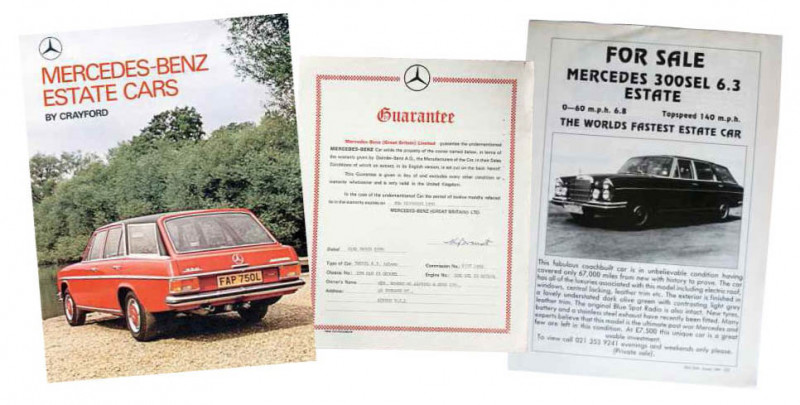
Clockwise, from left Incorporating boot lip makes tailgate design far better resolved; mighty M100 received a full mechanical refurb; interior was height of luxury as '60s waned.
Clockwise, from left Typically domineering on the road; there was a Crayford brochure (Giles Chapman Archive); M-B's original guarantee; McAlpine's full-page ad in Car to sell the car on.


